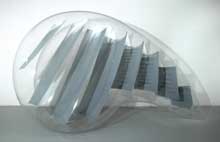The work that Doreen McCarthy makes
is transparent. Her discourse is clear and structured; the results are
surprisingly sensuous. Her dialogue between form, structure, and
environment is clearly represented by the new body of work presented at
UCU gallery in New York. Formalist concerns have always been at the
heart of McCarthy’s work. In her new exhibition Viewfinder she
confronts the viewer with a revealing dialogue between real and
suggested space with a lightness of touch that is witty without being
fluffy. Where her work succeeds most is in the balance between tension
and resistance.
Dorteen Doreen McCarthy McCarthy’s work is a marriage of the minimalist
attraction to self-evident structure and the technical precision that is
required in order to make these sculptures inflatable. This is not pop
art.
The works inhabit their own individual three-dimensional space while
also engaging with their immediate surrounds. Sculptural engagement
with architecture has a lineage that goes right back to the first
buildings and the first addition of sculptural motifs. Over the years
the dialogue has progressed and mutated through to architecture as
sculpture. This discourse is clear in the work of Daniel Liebskind or
Frank Ghery and it is also where McCarthy’s work is situated. Her
I-beam is a taut plastic sheet, her exterior facade a vinyl skin. The
transparency of the sculptures’ skin mediates and filters between the
constructed inner space and the surrounding room. She literally
breathes life into the debate.
|
-
The fluidity between sculpture and environment, real and perceived, is
further heightened by her installation of the works. Although each work
is self-sufficient she has chosen to present the works in two different
installation environments. In the first, she presents the more
traditional three-dimensional sculptural works and places them in an
aluminum corridor. As the surface of the sculptures are clear the
internal structures of the works are revealed to the viewer and to the
dramatic gallery lighting. The light passing through the clear plastic
skin bounces off the brightly colored opaque vinyl structure inside,
which in turn reflects into the surrounding aluminum clad walls. The
effect is to blur the division between artwork and environment, both
elements simultaneously inform each other as the sculpture’s exterior
skin almost disappears in this hall of muted mirrors.
In the second, and more rigorous installation,
McCarthy has chosen to paint the entire room white including the floor
and ceiling. It is here where she has directed the interplay between
light and shadow to maximum effect. The key players in this
installation are hanging from the ceiling. Clear panels in relief are
suspended in space, each containing an inflated form that reveals itself
as the viewer interacts through this plastic maze of light and shadow.
Again the specifics of the lighting allow the hanging works to act like
modern day magic lanterns projecting a sculptor’s drawings on the walls
and floor. The refraction of light through the vinyl creates a motif
akin to the surface of water, that echoes the works hanging in space and
wraps itself around the room and the viewer; for these works beg close
inspection.
Their fragility is poignantly evident. These sculptures stand before the
consequential step of giving form to space and imagination, no longer
looking at sculpture as material three-dimensionality, but rather
considering it as a formal phenomenon in space. Transparency veils and
binds the different dimensions of existence and, in the case of Doreen
McCarthy’s inflatable sculptures, the sky clearly is not the limit.
Rory Donaldson
|

